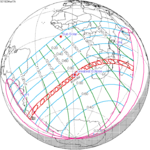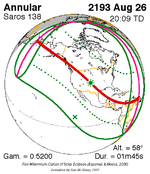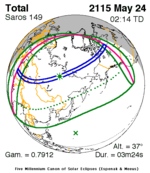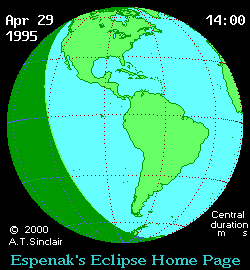Solar eclipse of April 29, 1995
| Solar eclipse of April 29, 1995 | |
|---|---|
| Type of eclipse | |
| Nature | Annular |
| Gamma | −0.3382 |
| Magnitude | 0.9497 |
| Maximum eclipse | |
| Duration | 397 s (6 min 37 s) |
| Coordinates | 4°48′S 79°24′W / 4.8°S 79.4°W |
| Max. width of band | 196 km (122 mi) |
| Times (UTC) | |
| Greatest eclipse | 17:33:20 |
| References | |
| Saros | 138 (30 of 70) |
| Catalog # (SE5000) | 9497 |
An annular solar eclipse occurred at the Moon's descending node of orbit on Saturday, April 29, 1995,[1][2][3][4][5][6][7][8] with a magnitude of 0.9497. A solar eclipse occurs when the Moon passes between Earth and the Sun, thereby totally or partly obscuring the image of the Sun for a viewer on Earth. An annular solar eclipse occurs when the Moon's apparent diameter is smaller than the Sun's, blocking most of the Sun's light and causing the Sun to look like an annulus (ring). An annular eclipse appears as a partial eclipse over a region of the Earth thousands of kilometres wide. Occurring about 3.5 days before apogee (on May 3, 1995, at 1:50 UTC), the Moon's apparent diameter was smaller.[9]
Annularity was visible in Peru, southeastern Ecuador, southeastern Colombia and Brazil. A partial eclipse was visible for parts of South America, Mexico, Central America, Florida, the Caribbean, and West Africa.
Images
[edit]Observations
[edit]A team of NASA's Johnson Space Center observed the annular eclipse near Puinahua District in the Peruvian Amazon rainforest. The weather was clear and the observations were successful.[10]
Eclipse season
[edit]This eclipse is part of an eclipse season, a period, roughly every six months, when eclipses occur. Only two (or occasionally three) eclipse seasons occur each year, and each season lasts about 35 days and repeats just short of six months (173 days) later; thus two full eclipse seasons always occur each year. Either two or three eclipses happen each eclipse season. In the sequence below, each eclipse is separated by a fortnight.
| April 15 Ascending node (full moon) |
April 29 Descending node (new moon) |
|---|---|
 |

|
| Partial lunar eclipse Lunar Saros 112 |
Annular solar eclipse Solar Saros 138 |
Related eclipses
[edit]Eclipses in 1995
[edit]- A partial lunar eclipse on April 15.
- An annular solar eclipse on April 29.
- A penumbral lunar eclipse on October 8.
- A total solar eclipse on October 24.
Metonic
[edit]- Preceded by: Solar eclipse of July 11, 1991
- Followed by: Solar eclipse of February 16, 1999
Tzolkinex
[edit]- Preceded by: Solar eclipse of March 18, 1988
- Followed by: Solar eclipse of June 10, 2002
Half-Saros
[edit]- Preceded by: Lunar eclipse of April 24, 1986
- Followed by: Lunar eclipse of May 4, 2004
Tritos
[edit]- Preceded by: Solar eclipse of May 30, 1984
- Followed by: Solar eclipse of March 29, 2006
Solar Saros 138
[edit]- Preceded by: Solar eclipse of April 18, 1977
- Followed by: Solar eclipse of May 10, 2013
Inex
[edit]- Preceded by: Solar eclipse of May 20, 1966
- Followed by: Solar eclipse of April 8, 2024
Triad
[edit]- Preceded by: Solar eclipse of June 28, 1908
- Followed by: Solar eclipse of February 27, 2082
Solar eclipses of 1993–1996
[edit]This eclipse is a member of a semester series. An eclipse in a semester series of solar eclipses repeats approximately every 177 days and 4 hours (a semester) at alternating nodes of the Moon's orbit.[11]
| Solar eclipse series sets from 1993 to 1996 | ||||||
|---|---|---|---|---|---|---|
| Descending node | Ascending node | |||||
| Saros | Map | Gamma | Saros | Map | Gamma | |
| 118 | May 21, 1993 Partial |
1.1372 | 123 | November 13, 1993 Partial |
−1.0411 | |
128 Partial in Bismarck, ND, USA |
May 10, 1994 Annular |
0.4077 | 133 Totality in Bolivia |
November 3, 1994 Total |
−0.3522 | |
| 138 | April 29, 1995 Annular |
−0.3382 | 143 Totality in Dundlod, India |
October 24, 1995 Total |
0.3518 | |
| 148 | April 17, 1996 Partial |
−1.058 | 153 | October 12, 1996 Partial |
1.1227 | |
Saros 138
[edit]This eclipse is a part of Saros series 138, repeating every 18 years, 11 days, and containing 70 events. The series started with a partial solar eclipse on June 6, 1472. It contains annular eclipses from August 31, 1598 through February 18, 2482; a hybrid eclipse on March 1, 2500; and total eclipses from March 12, 2518 through April 3, 2554. The series ends at member 70 as a partial eclipse on July 11, 2716. Its eclipses are tabulated in three columns; every third eclipse in the same column is one exeligmos apart, so they all cast shadows over approximately the same parts of the Earth.
The longest duration of annularity was produced by member 23 at 8 minutes, 2 seconds on February 11, 1869, and the longest duration of totality will be produced by member 61 at 56 seconds on April 3, 2554. All eclipses in this series occur at the Moon’s descending node of orbit.[12]
| Series members 20–41 occur between 1801 and 2200: | ||
|---|---|---|
| 20 | 21 | 22 |
 January 10, 1815 |
 January 20, 1833 |
 February 1, 1851 |
| 23 | 24 | 25 |
 February 11, 1869 |
 February 22, 1887 |
 March 6, 1905 |
| 26 | 27 | 28 |
 March 17, 1923 |
 March 27, 1941 |
 April 8, 1959 |
| 29 | 30 | 31 |
 April 18, 1977 |
 April 29, 1995 |
 May 10, 2013 |
| 32 | 33 | 34 |
 May 21, 2031 |
 May 31, 2049 |
 June 11, 2067 |
| 35 | 36 | 37 |
 June 22, 2085 |
 July 4, 2103 |
 July 14, 2121 |
| 38 | 39 | 40 |
 July 25, 2139 |
 August 5, 2157 |
 August 16, 2175 |
| 41 | ||
 August 26, 2193 | ||
Metonic series
[edit]The metonic series repeats eclipses every 19 years (6939.69 days), lasting about 5 cycles. Eclipses occur in nearly the same calendar date. In addition, the octon subseries repeats 1/5 of that or every 3.8 years (1387.94 days). All eclipses in this table occur at the Moon's descending node.
| 21 eclipse events between July 11, 1953 and July 11, 2029 | ||||
|---|---|---|---|---|
| July 10–11 | April 29–30 | February 15–16 | December 4 | September 21–23 |
| 116 | 118 | 120 | 122 | 124 |
 July 11, 1953 |
 April 30, 1957 |
 February 15, 1961 |
 December 4, 1964 |
 September 22, 1968 |
| 126 | 128 | 130 | 132 | 134 |
 July 10, 1972 |
 April 29, 1976 |
 February 16, 1980 |
 December 4, 1983 |
 September 23, 1987 |
| 136 | 138 | 140 | 142 | 144 |
 July 11, 1991 |
 April 29, 1995 |
 February 16, 1999 |
 December 4, 2002 |
 September 22, 2006 |
| 146 | 148 | 150 | 152 | 154 |
 July 11, 2010 |
 April 29, 2014 |
 February 15, 2018 |
 December 4, 2021 |
 September 21, 2025 |
| 156 | ||||
 July 11, 2029 | ||||
Tritos series
[edit]This eclipse is a part of a tritos cycle, repeating at alternating nodes every 135 synodic months (≈ 3986.63 days, or 11 years minus 1 month). Their appearance and longitude are irregular due to a lack of synchronization with the anomalistic month (period of perigee), but groupings of 3 tritos cycles (≈ 33 years minus 3 months) come close (≈ 434.044 anomalistic months), so eclipses are similar in these groupings.
| Series members between 1801 and 2200 | ||||
|---|---|---|---|---|
 October 9, 1809 (Saros 121) |
 September 7, 1820 (Saros 122) |
 August 7, 1831 (Saros 123) |
 July 8, 1842 (Saros 124) |
 June 6, 1853 (Saros 125) |
 May 6, 1864 (Saros 126) |
 April 6, 1875 (Saros 127) |
 March 5, 1886 (Saros 128) |
 February 1, 1897 (Saros 129) |
 January 3, 1908 (Saros 130) |
 December 3, 1918 (Saros 131) |
 November 1, 1929 (Saros 132) |
 October 1, 1940 (Saros 133) |
 September 1, 1951 (Saros 134) |
 July 31, 1962 (Saros 135) |
 June 30, 1973 (Saros 136) |
 May 30, 1984 (Saros 137) |
 April 29, 1995 (Saros 138) |
 March 29, 2006 (Saros 139) |
 February 26, 2017 (Saros 140) |
 January 26, 2028 (Saros 141) |
 December 26, 2038 (Saros 142) |
 November 25, 2049 (Saros 143) |
 October 24, 2060 (Saros 144) |
 September 23, 2071 (Saros 145) |
 August 24, 2082 (Saros 146) |
 July 23, 2093 (Saros 147) |
 June 22, 2104 (Saros 148) |
 May 24, 2115 (Saros 149) |
 April 22, 2126 (Saros 150) |
 March 21, 2137 (Saros 151) |
 February 19, 2148 (Saros 152) |
 January 19, 2159 (Saros 153) |
 December 18, 2169 (Saros 154) |
 November 17, 2180 (Saros 155) |
 October 18, 2191 (Saros 156) | ||||
Inex series
[edit]This eclipse is a part of the long period inex cycle, repeating at alternating nodes, every 358 synodic months (≈ 10,571.95 days, or 29 years minus 20 days). Their appearance and longitude are irregular due to a lack of synchronization with the anomalistic month (period of perigee). However, groupings of 3 inex cycles (≈ 87 years minus 2 months) comes close (≈ 1,151.02 anomalistic months), so eclipses are similar in these groupings.
| Series members between 1801 and 2200 | ||
|---|---|---|
 August 27, 1821 (Saros 132) |
 August 7, 1850 (Saros 133) |
 July 19, 1879 (Saros 134) |
 June 28, 1908 (Saros 135) |
 June 8, 1937 (Saros 136) |
 May 20, 1966 (Saros 137) |
 April 29, 1995 (Saros 138) |
 April 8, 2024 (Saros 139) |
 March 20, 2053 (Saros 140) |
 February 27, 2082 (Saros 141) |
 February 8, 2111 (Saros 142) |
 January 20, 2140 (Saros 143) |
 December 29, 2168 (Saros 144) |
 December 9, 2197 (Saros 145) |
|
References
[edit]- ^ "April 29, 1995 Annular Solar Eclipse". timeanddate. Retrieved 10 August 2024.
- ^ "Hoy, eclipse solar parcial". La Prensa. Panama City, Panama, Panama. 1995-04-29. p. 44. Retrieved 2023-10-18 – via Newspapers.com.
- ^ "Eclipse anular de sol causa entusiasmo y advertencias en Perú". El Nuevo Herald. Miami, Florida. 1995-04-29. p. 21. Retrieved 2023-10-18 – via Newspapers.com.
- ^ "AstroData". The Morning Call. Allentown, Pennsylvania. 1995-04-29. p. 86. Retrieved 2023-10-18 – via Newspapers.com.
- ^ "UNH has another alternative paper". The Boston Globe. Boston, Massachusetts. 1995-04-30. p. 303. Retrieved 2023-10-18 – via Newspapers.com.
- ^ "Partial eclipse is seen at Deltona observatory". The Orlando Sentinel. Orlando, Florida. 1995-04-30. p. 283. Retrieved 2023-10-18 – via Newspapers.com.
- ^ "Annular eclipse in the limelight". Detroit Free Press. Detroit, Michigan. 1995-04-30. p. 5. Retrieved 2023-10-18 – via Newspapers.com.
- ^ "Peruvians see unusual eclipse". The Boston Globe. Boston, Massachusetts. 1995-04-30. p. 17. Retrieved 2023-10-18 – via Newspapers.com.
- ^ "Moon Distances for London, United Kingdom, England". timeanddate. Retrieved 10 August 2024.
- ^ Paul D. Maley. "Ring Eclipse in the Amazon Rainforest". Eclipse Tours. Archived from the original on 18 September 2020.
- ^ van Gent, R.H. "Solar- and Lunar-Eclipse Predictions from Antiquity to the Present". A Catalogue of Eclipse Cycles. Utrecht University. Retrieved 6 October 2018.
- ^ "NASA - Catalog of Solar Eclipses of Saros 138". eclipse.gsfc.nasa.gov.
External links
[edit]- Earth visibility chart and eclipse statistics Eclipse Predictions by Fred Espenak, NASA/GSFC
Photos:





